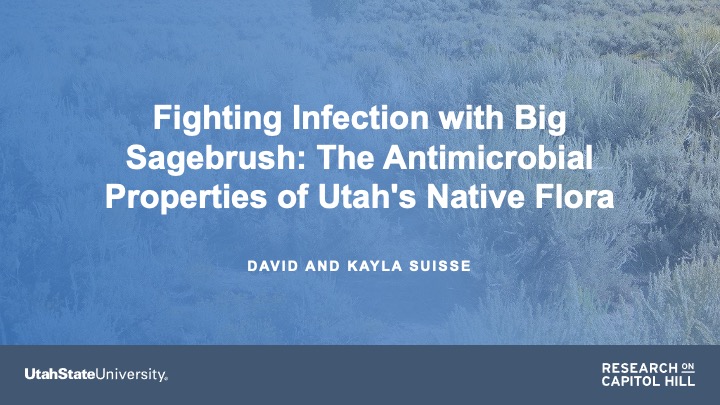Title: Antimicrobial Assay of Artemisia tridentata
Name: David and Kayla Suisse
Mentor: Amita Kaundal
Many plants secrete substances to create a more favorable environment, including chemicals that kill pathogenic microbes or competing plants. Artemisia tridentata, also known as “Big Sagebrush,” is prevalent in the Rocky Mountain region of the United States and is known to have antimicrobial capabilities. We are studying the antimicrobial activity of Artemisia tridentata. Studies report that chemicals released by the leaves and branches of A. tridentata affect bacteria native to deer rumen. Another study showed that 27 actinomycetes (anaerobic bacteria that form colonies) strains found in the rhizosphere of A. tridentata demonstrated antibacterial activities when tested on E. coli, Bacillus subtilis and Staphylococcus aureus. Native Americans traditionally used A. tridentata to relieve stomach pain, colds, coughs, sore eyes, snake bites and as an insect repellent. Articles regarding antimicrobial activities in A. tridentata were published between 1967 and 2004. With the chronological gaps and considering the progress that biological and molecular technology has made in recent years, knowledge of the chemicals released by A. tridentata lies largely untapped. In this study, we are investigating the antimicrobial activities of the leaves, stem, roots, and flowers of A. tridentata initially by the agar well diffusion method and followed by validating with the agar disk diffusion method. We are checking the antimicrobial activity of the extract from different plant parts of A. tridentata on common bacteria such as E. coli, Bacillus subtilis, and some Pseudomonas spp. of plant pathogens, as well as on several human pathogens, including Staphylococcus aureus. The knowledge obtained from this research will further help in the identification and characterization of the secondary metabolites or chemicals involved in antimicrobial activity of sagebrush. Medicinal plants provide a healthy, natural alternative to conventional medication, and may lead to new insights on antibiotics and pharmaceuticals. Besides, Artemisia tridentata is a plant native to Utah and Idaho. It grows everywhere in the surrounding area, making it almost free to produce.



